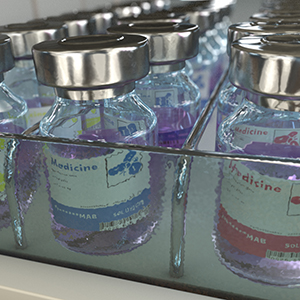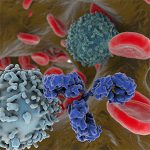 On August 20, 2021, the European Commission authorized marketing of Bimzelx (bimekizumab) in the EU for the treatment of moderate to severe plaque psoriasis in adults who are candidates for systemic therapy. Bimekizumab is a humanized IgG1 kappa antibody that selectively inhibits IL-17A and IL-17F by binding regions that are common to these pro-inflammatory cytokines, which share ~50% sequence identity and are expressed as homodimers and IL-17A/F heterodimers. Bimekizumab is approved at a recommended dose of 320 mg, administered by two subcutaneous injections every four weeks to week 16 and every eight weeks thereafter. [1]
On August 20, 2021, the European Commission authorized marketing of Bimzelx (bimekizumab) in the EU for the treatment of moderate to severe plaque psoriasis in adults who are candidates for systemic therapy. Bimekizumab is a humanized IgG1 kappa antibody that selectively inhibits IL-17A and IL-17F by binding regions that are common to these pro-inflammatory cytokines, which share ~50% sequence identity and are expressed as homodimers and IL-17A/F heterodimers. Bimekizumab is approved at a recommended dose of 320 mg, administered by two subcutaneous injections every four weeks to week 16 and every eight weeks thereafter. [1]
The decision to grant a marketing approval was supported by results from 3 Phase 3 studies that included an active comparator arm, ustekinumab (Stellara®; BE VIVID study; NCT03370133), adalimumab (Humira®; BE SURE study; NCT03412747), or secukinumab (Cosentyx®; BE RADIANT study; NCT03536884). All three pivotal studies met their co-primary endpoints at Week 16, demonstrating superiority of bimekizumab over the active comparator in certain defined measures (e.g., Psoriasis Area and Severity Index). Clinical responses achieved with bimekizumab at Week 16 were maintained up to one year. [2-4] Coprimary endpoints were also met in the Phase 3 BE READY study (NCT03410992), which investigated the efficacy and safety of bimekizumab in patients with moderate to severe plaque psoriasis compared to placebo. [5]
Bimzelx is the 8th antibody therapeutic to be first approved for marketing in the EU or US in 2021.
- European Medicines Agency. Bimzelx public assessment report.
- Reich K, Papp KA, Blauvelt A, et al. Bimekizumab versus ustekinumab for the treatment of moderate to severe plaque psoriasis (BE VIVID): efficacy and safety from a 52-week, multicentre, double-blind, active comparator and placebo-controlled phase 3 trial. Lancet. 2021;397(10273):487-498.
- Warren RB, Blauvelt A, Bagel J, et al. Bimekizumab versus Adalimumab in Plaque Psoriasis. N Engl J Med. 2021;385(2):130-141.
- Reich K, Warren RB, Lebwohl M, Gooderham M, Strober B, Langley RG, Paul C, De Cuyper D, Vanvoorden V, Madden C, Cioffi C, Peterson L, Blauvelt A. Bimekizumab versus Secukinumab in Plaque Psoriasis. N Engl J Med. 2021 Jul 8;385(2):142-152.
- Gordon KB, Foley P, Krueger JG, et al. Bimekizumab efficacy and safety in moderate to severe plaque psoriasis (BE READY): a multicentre, double-blind, placebo-controlled, randomised withdrawal phase 3 trial. Lancet. 2021;397(10273):475-486.



